The score for Virtutes Occultae can be viewed here. Its recording is available on the composer's Bandcamp page.
Prelude
Virtutes Occultae is a 90-minute composition for six microtonally tuned and physically modeled digital pianos in album form, with 18 individual pieces. The creation of Virtutes Occultae occurred simultaneously with an extensive study of Harry Partch’s Delusion of the Fury1, and is deeply indebted to this work and the music and theory of Harry Partch in general. While there are few stylistic similarities between my work and that of Partch, attitudes toward pitch organization, large-scale structure, and instrumentation are linked. Indeed, the influence of Partch on Virtutes Occultae is omnipresent on a structural and conceptual level.
Partch’s extended just intonation scale of 43 tones per octave demands a remarkable level of pitch precision, while the compositions themselves have a free and improvisational sensibility. Additionally, Partch often obscures a clear audibility of the pitches and harmony because of the timbre of his instruments and the heavy use of glissandi. This may seem paradoxical, but in fact the interplay between the strictness of the tuning system and the freedom of the compositional style suggests that the expressivity of the music is more valuable than showcasing theory. Without the rigorous theoretical basis for his music, as laid out in Genesis of a Music, it would be difficult to imagine Partch being able to achieve the expressive breadth while maintaining the sense of unity that characterizes his pieces. Similarly, Virtutes Occultae seeks a balance between systematic and arbitrary approaches to composition, between free and strict styles. Like Partch, some of the formality comes from the formation of the microtonal scale, but it also via algo-rhythmic tools that were used to sketch many of the pieces.
Virtutes Occultae was created principally as a recording, second as a multichannel audio installation, and third as a concert piece. The music was realized entirely electronically, using physical modeling in Pianoteq, which is commercial software that synthesizes the sound of acoustic instruments with a high degree of realism and allows for the alteration of many properties of the piano model, including the tuning of individual strings, the overtone properties of the strings, the softness of the hammers, and the placement and types of microphones recording in the virtual space.
Microtonal Implications
In the case of music that uses microtonal tunings and therefore a relatively unfamiliar set of pitch materials, the nature of the model or representation of the pitch space may significantly affect aspects of compositional thinking. The study of such models is thus not a sterile exercise in abstract theory but a necessary starting point for a detailed understanding of the music itself. Bob Gilmore2
The tuning, resonance, and construction of musical instruments are fundamental to their sound and have harmonic and expressive implications. There is a musical reasoning behind Vivaldi, in his Four Seasons, choosing the key of E major for "Spring", a key that is bright and resonant with the open strings of the violin, while "Winter" is in F minor, a muted key that is much less resonant with the open strings. While a transposition of this music is still recognizable, the tone and character have been significantly altered.
Virtutes Occultae is written in extended just intonation and the following section goes into detail about how the microtonal pianos are tuned. This article presupposes a basic understanding of just intonation and related terminology. For readers who are unfamiliar, Kyle Gann’s website offers are excellent introduction to the topic.
Tuning the Pianos
The tuning of the six pianos in Virtutes Occulate, shown in figure 1, is an integral part of the composition, serving as the departure point for the composition. These piano tunings were inspired by Harry Partch’s conception of tonality from Genesis of a Music as well as his “One-Footed Bride,” which will be discussed below. Unlike Partch, I set no firm limit to the interval ratios, instead favoring an arrangement of 12 notes per octave for each of the six pianos.. O-tonalities and U-tonalities are Partch’s terms for a collection of intervals with shared denominators and numerators respectively. The second divergence from Partch is that I am using only O-tonalities (no U-tonalities.) Partch groups O-tonalities and U-tonalities according to shared denominators or numerators with terms such as the 3O-tonality or 11U-tonality. For example, the 8/7. 10/7, and 11/7 intervals are all part of the 7O-tonality. The significance of this grouping is that all tones in an O-tonality fit into a single overtone series. Similarly, the U-tonalities represent an inverted overtone series (subharmonic series). The decision to only include O-tonalities in Virtutes Occultae is not a rejection of the value of a subharmonic series, only a choice to limit my scope in an already vast array of pitches.
Partch designed his scale to be symmetrical around the tritone, and the scale tones are as evenly spaced as possible by filling in the larger gaps inherent in a single-fundamental just intonation system with secondary relationships. For example, in Partch’s scale the large gap between the 7/6 and 6/5 interval is bridged by including the 32/27 interval. I specifically designed an uneven and asymmetrical scale for Virtutes Occultae, as I find this irregularity in spacing provides more subjectively attractive harmonic and melodic possibilities.
Each piano in Virtutes Occultae is tuned to a different overtonality. In other words, each piano is tuned to intervals with a shared denominator in a just intonation system with a common fundamental. Additionally, each piano has a nearly unique set of pitches, resulting in each one carrying a distinct Partchian tonality built into their tuning. This feature of the tuning is exploited in the second piece of Virtutes Occultae, "Aria", which begins with an extended section that features piano four as the soloist, presenting a clear sense of the 7O-tonality.
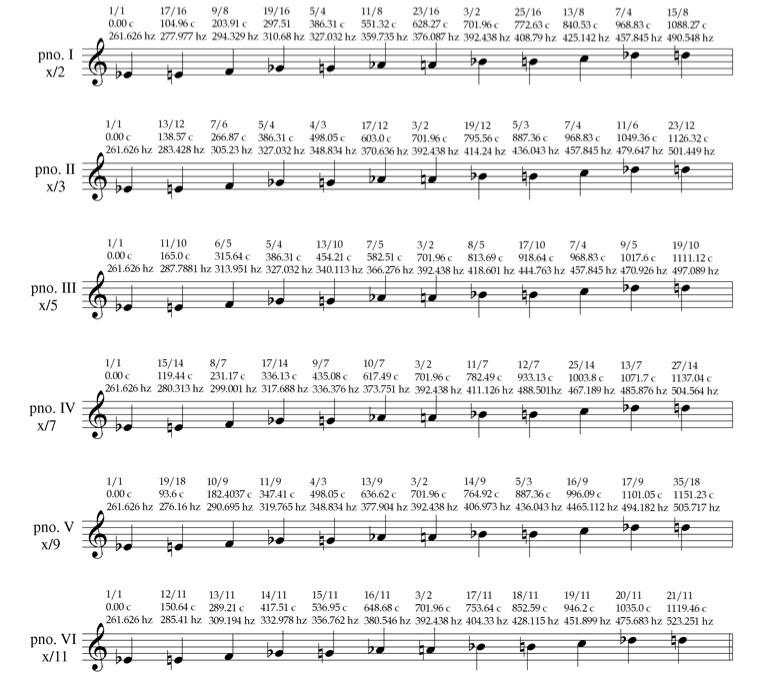
Tuning each piano as a different 0-tonality, which represents harmonic areas heard in the actual music, echoes Partch’s approach to the design and tuning of his invented instruments in a way that reinforces his harmonies and is generally consonant and resonant unto themselves. For example, the diamond marimba is constructed as a physical tonality diamond with O-tonalities arranged in diagonal rows in an upward direction and U-tonalities as diagonal rows in a downward direction. The tuning of the instruments in Partch’s music reflects his musical language, and the tuning of the pianos in Virtutes Occultae similarly has a structural and organizational function.
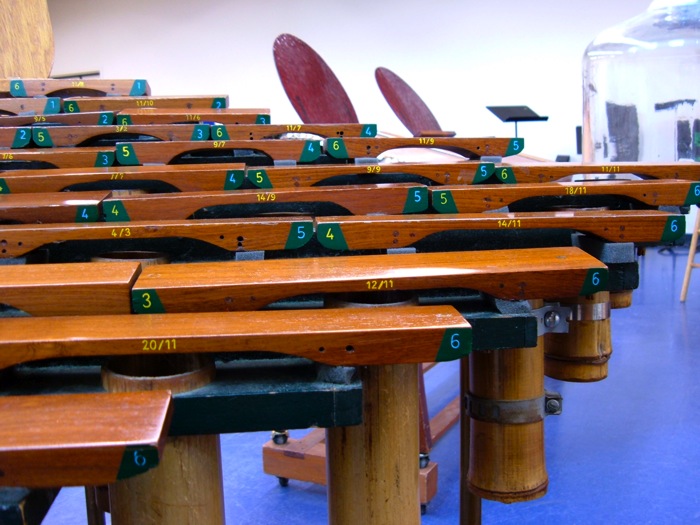
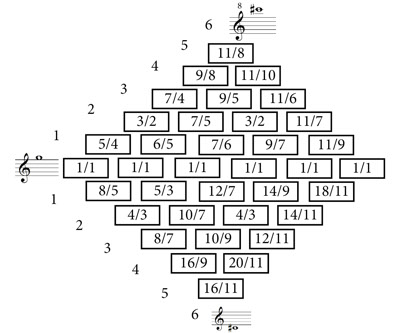
The fundamental of E-flat is shared between all six pianos, an acknowledgment of the influence of La Monte Young’s Well-Tuned Piano (with the caveat that the fundamental for Young’s work is not precisely E-flat). Despite limiting the scale to a single fundamental throughout Virtutes Occultae, the perceived tonic is varied in many of the pieces by creating subgroups of pitches that harmonically reinforce notes other than the 1/1. The scale used in Virtutes Occultae presents a pool of pitches that is rich enough to tonicize many different notes, which is also a key feature of Partch’s 43-note scale. Indeed, Partch usually tonicizes various notes from the 11-limit* core of his scale more often than the 1/1 fundamental. This idea will be explored further in the section below discussing expressivity.
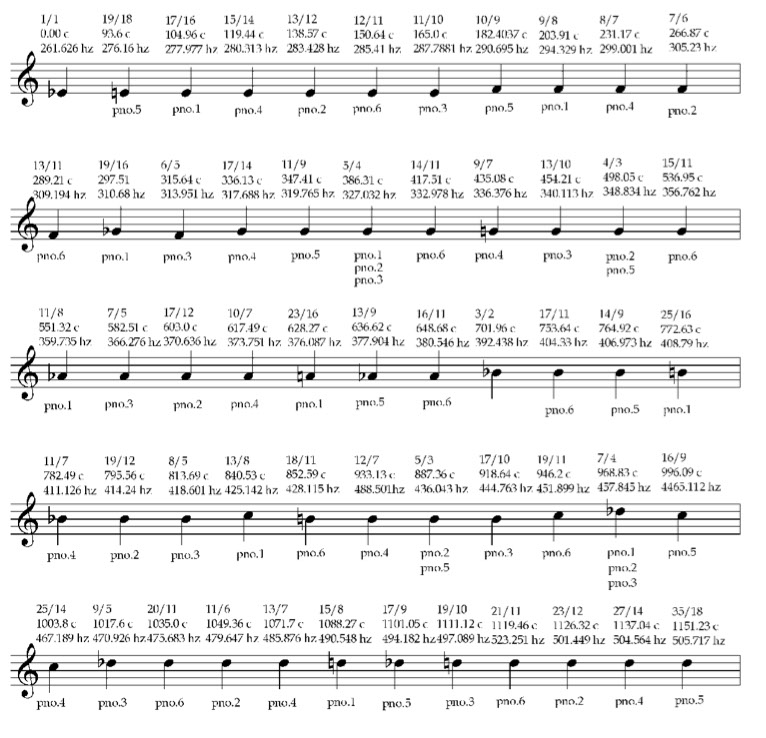
Figure 4 shows the set of 19 hexads** (one is actually a 7-note collection) used to underpin harmony in Virtutes Occultae, each centering on a different pitch. These chords were a very important tool in creating this music as they provide harmonic orientation and help in controlling the expansive pool of 56 notes per octave. Which pitches were chosen to form hexads was decided arbitrarily—a collection of roots that, as a scale, is highly asymmetrical. For example, the region around the minor 7th contains four tightly spaced roots, whereas there is a leap of 150 cents between the 11/8 and the 3/2.
These hexads were used in many ways, at times underpinning large sections or even entire pieces, and at other times used in a way analogous to chords that may be moved between on a smaller time scale. The clearest integration of these hexads relate to the algo-rhythmic aspects of the composition. These chords are subgroupings of the scale and may be used to produce the suggestion of a tonal syntax and to help avoid a constant sensation of the 1/1 E-flat as tonal center.
In Partch, harmonic organization is built into the tuning of his instruments. A clear example of this are his two kitharas, where sets of six strings are tuned to different chords in various O-tonalities and U-tonalities. This approach to instrumental tuning, as also evidenced by the layout of the previously discussed Diamond Marimba, provides both a pool of harmonies as well as reflecting Partch’s harmonic language, grouping pitches according to O-tonalities and U-tonalities. I took a similar approach to harmony in Virtutes Occultae, where these hexads are integrated into the music in an almost incidental way, often being combined with notes outside of the harmony or overlapping in unpredictable ways.
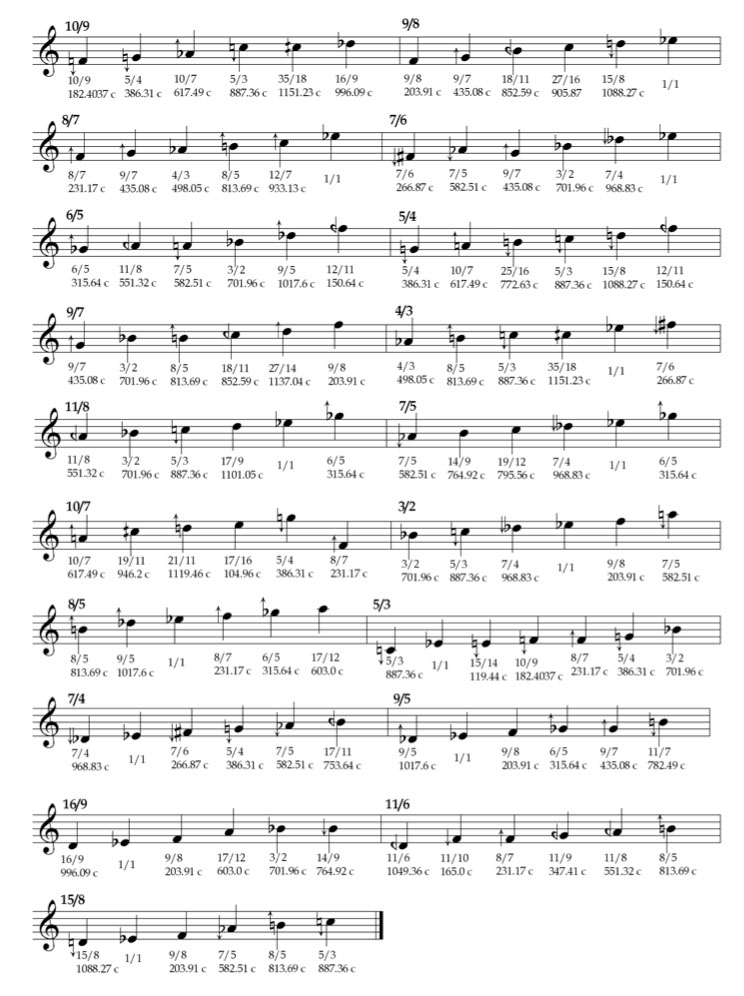
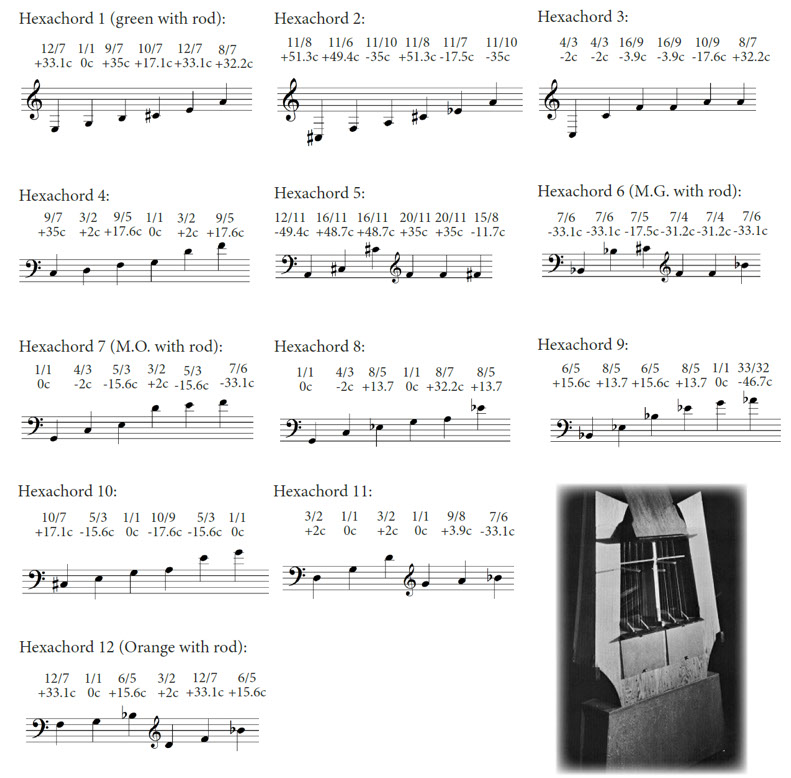
Expressivity and the one-footed bride
Any assignment of a particular narrative to a piece of music is adventitious, indeed open to ridicule. Yet a refusal to allow music its narrative moment is also, I believe, a mistake. Daniel Albright.3
Partch sought to create a music that was expressive and meaningful, deeply connected to human experience. He conceptualized this as corporeality, which he contrasted with abstractionism—music for music’s sake. In striving to create corporeal art, Partch brought together music, choreography, and setting, all connected to a text, which was often a parable. Delusion of the Fury follows the model of ancient Greek drama, presenting a tragedy followed by a comedy. The tragedy is based on Atsumori, a Noh play, and the comedy is based on Justice, an Ethiopian folk tale—both of which deal with the futility of anger.
The ancient Greeks connected harmonia with ethos and pathos, believing that music could rouse emotions and persuade listeners to thoughts and actions.4 Partch applied this idea that intervals contain innate expressive meaning to his music as shown by a fascinating figure in his Genesis of a Music that he calls the "One-Footed Bride"5. The "One-Footed Bride" charts the intervals of his scale according to expressive regions in a symmetrical structure around the tritone. There are many fascinating aspects to the "One-Footed Bride": the regions of the scale are divided into a diatonic superstructure that draws equivalencies between thirds and sixths, seconds and sevenths, the octave and unison, and the perfect fourth and the perfect fifth. Additionally, the chart echoes how we traditionally understand the stability of chords in Western concert music: the perfect intervals are associated with power, the tritone with suspense, the thirds and sixths with emotions. (Here we can think of the generalization that the major is perceived as happy and the minor as sad as an example of the third being associated with emotional content.)
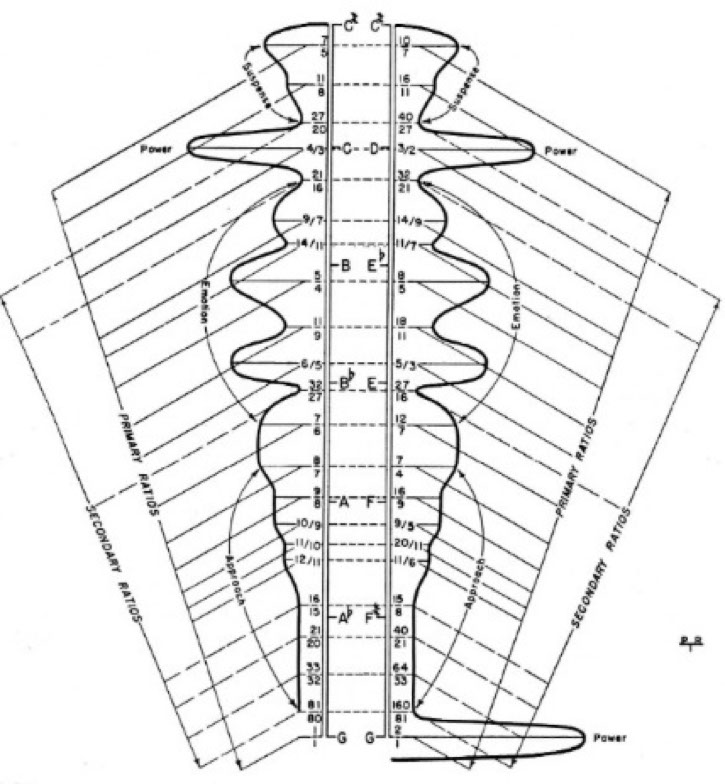
The "One-Footed Bride" introduces new pathways for interpreting Partch’s music. The prominence of certain pitches in Delusion of the Fury serves as a path toward understanding the implementation of the "One-Footed Bride". The chart below provides a summary of the prominent pitches and tonalities for the entire Delusion of the Fury. We immediately discover that 1/1 and the 1O-tonality, what might be considered the natural “home key” in Partch’s scale, is only rarely used. Instead, 16/9 assumes the role of home key, being returned to repeatedly throughout the work as well as serving as the first and final prominent note in a way analogous to a tonic chord.
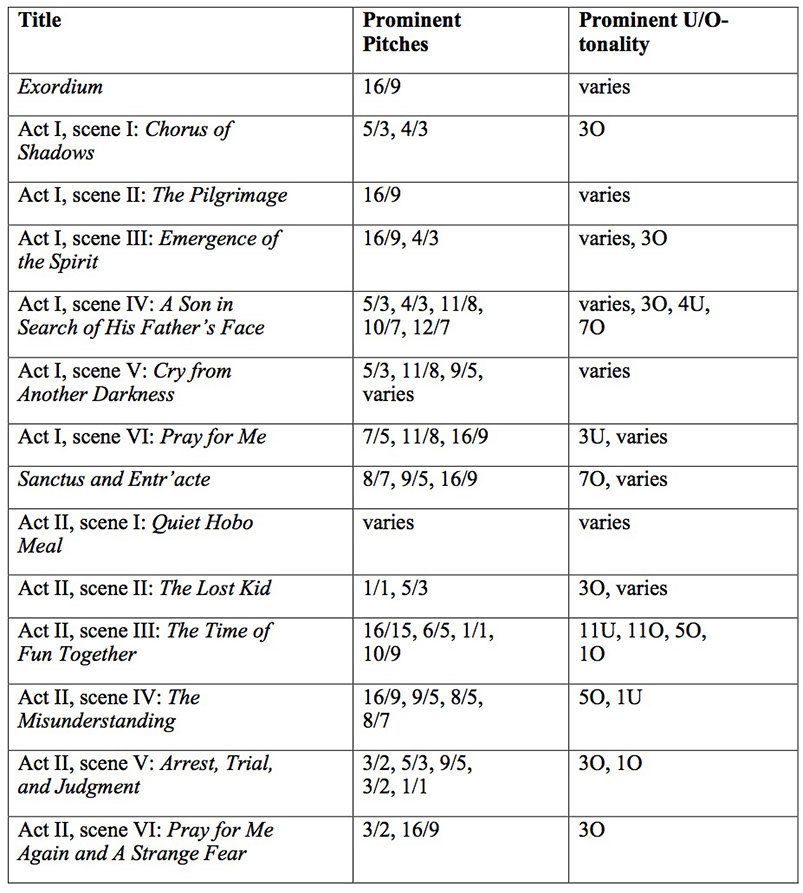
In Delusion of the Fury, relationships between pitches with the narrative content of the story can be expounded for any given section. For example, let’s consider a brief section from Act II, scene V: Arrest, Trial, and Judgment. In this scene the 3/2 is associated with the power and authority of the judge, used both at the moments of introducing the judge as well as when the judge lays down the sentencing. Partch is not depicting the action through tone painting but instead through the experience of the notes, through Partch’s own subjective sense of corporeality.
The "One-Footed Bride" and this broad analysis of Delusion of the Fury have informed the composition of Virtutes Occultae in two important ways. First, there is the idea of writing melodies with minuscule microtonal steps that are conceived as an expressive shading on the idea of an interval. For example, a 9/8 major second shifting to a 10/9 minor whole tone, a shift of approximately 22 cents (hundredths of a semitone), has a distinct expressive quality, albeit one that is dependent on context and highly subjective in nature. Secondly, the way in which the 1/1 of the scale is not treated automatically as the tonal center enriches the expressive possibilities of the scale by bringing to light complex intervallic relationships and different shadings within an overarching diatonic structure.
Algorithms and Improvisation
As part of composing Virtutes Occultae, I wrote a Max/MSP program that could both generate music algorithmically as well as serve as an means for improvisation using a MIDI interface. This MIDI interface was not a keyboard; it was a surface of dials and buttons that could be programmed to set high-level parameters like register, pulsation speed, harmony, and so on. The basic premise of this program was that it could take rhythm and assign pitches in the scale according to various weightings. The selection of the pitches ranged from pure randomness to favoring notes from the hexads shown in figure 4.
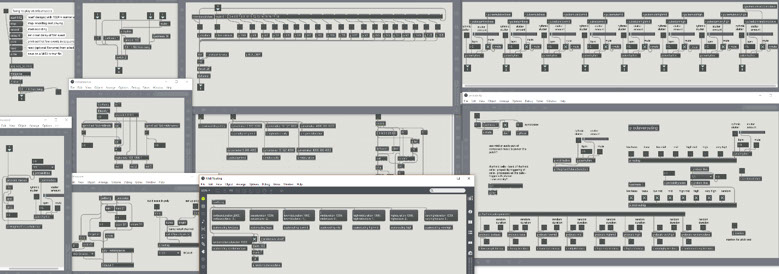
The goal of this patch was to produce elemental materials and cloud-like textures, and so the rhythmic generation aspect of the patch was designed to create saturated textures, most often relying upon eight pulse generators that could be set at different speeds and with different degrees of stutter.
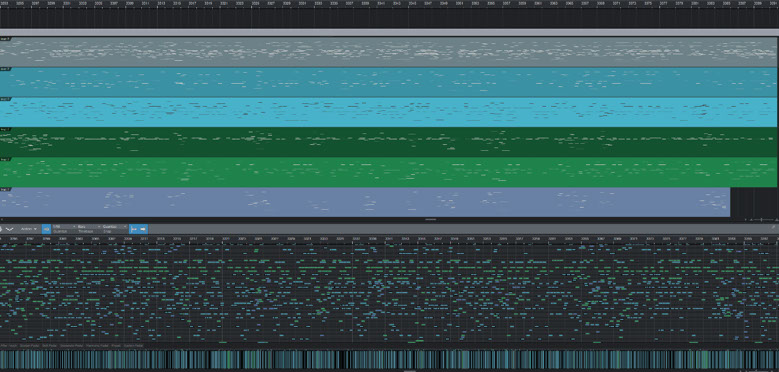
This MIDI roll displays the result of one of these improvisations, producing a constant saturation of notes, which would then be treated as raw material to be sculpted manually.
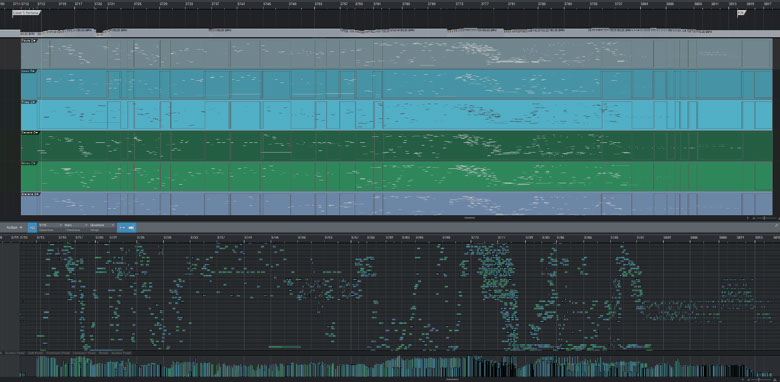
The finished piece is significantly reduced from the original improvised material. Aspects from the algorithmic improvisations were used throughout many of the pieces in Virtutes Occultae, but the pieces that are most directly derived from these improvisations are the four “cloud” tracks.
This fusion of improvisation with algorithmic generation was at the heart of Virtutes Occultae, exploring the relationship between control and chaos, something strict counterbalanced with something free. Although this idea manifests very differently in my work, the concept is derived directly from my experience of Partch, whose theory of music and tuning system demand precision and strictness but whose musical compositions are liberated from a pedantic showcase of his scale.
Historical Models
Each piece in Virtutes Occultae draws upon other music or musical traditions as a model of some type. These influences are listed below, but the relationships are often tenuous, drawing upon general characteristics and personal impressions rather than direct quotation or allusion. The one exception is the Chorale, for which I reworked a short excerpt from a movement of a Beethoven piano sonata.
The Phases piece presents the clearest relationship with the model, where the technique that Reich developed in his Piano Phase has been taken wholesale and recontextualized in an extended just intonation context. This is a good example of an existing technique being transposed into a microtonal scale, exploring the possibilities that this new context provides.
Switched on C.P.E. Bach
An example of a piece that veers farther from the model, "Cloud Fantasia" is a wild and improvisatory piece in the spirit of a C.P.E. Bach Fantasia. It’s a piece with many notes, large sweeping gestures, and a frenzied, unpredictable sense of motion. "Cloud Fantasia" sounds nothing like C.P.E. Bach but is related indirectly on a conceptual and structural level. "Cloud Fantasia" attempts to capture an ecstatic state of music making as I imagined the improvised fantasias of C.P.E. Bach.
As much as Partch rejected the European tradition of concert music, he embraced other traditions that may not be immediately apparent, chiefly Native American song and Cantonese opera as he experienced it in 1930s San Francisco. The influence of Cantonese opera is particularly strong and immediately recognizable for listeners familiar with this tradition, an influence that has been well researched by S. Andrew Granade.6 Partch pieced together his musical language from many disparate origins, coming together to form a highly original voice.
Corporeality
The reason for using Pianoteq over real pianos for Virtutes Occultae was twofold. First is the impracticality of arranging a concert or recording session for six pianos where nearly every string in each piano is tuned differently. I have never been able to retune a single string of a piano for a concert let alone 588 strings. The second reason stems from an interest in looking for a new approach to composition that didn’t rely upon a score or human performers but where I could work more directly with the sound. In this way, although Virtutes Occultae uses the timbre of a piano exclusively and provides an illusion of an acoustic sound source and space, the compositional process is grounded in electronic music.
Partch would have considered Virtutes Occultae an example of abstractionism, a piece of art that is antithetical to his ideal of corporeality. Virtutes Occultae is best listened to alone, on headphones, perhaps even with the eyes closed. There is no sense of communal art, there is no sense of human bodies, and certainly no narrative or visual aspect. Instead, one hears only digital instruments, with no human performers other than the composer.
Partch and Legacy
Partch’s legacy is complex, as he did not think other composers should write like him, and so he had no composition students. While Ben Johnston lived in a pseudo-apprenticeship situation in Gualala, California, with Harry Partch, he was told by Partch that “If [he] or anyone else ever claimed to be a student of his, he would cheerfully strangle us.”7
Today, it is difficult to study his music for a number of reasons: his scores are written in tablature notation where the resultant notes are hidden behind a level of abstraction. Performances of his music are hard to come by, and his instruments are only available in exceptional circumstances. As a composer who values his work, I hope that Partch would approve of the type of homage that Virtutes Occulate represents as it attempts to expand upon some of the principles of Partch’s theories and music while rejecting other aspects and searching for a unique path.